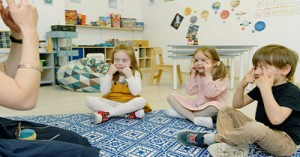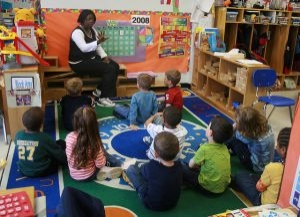Redirection is among the most effective proactive behaviour guidance methods in young children. It consists of simple cues or instructions that prevent problem behaviours from escalating and help children to be more engaged in their learning. The following article provides information on How Redirecting Behaviour Help, Types Of Redirecting Behaviour, Redirecting Behaviour Strategies and more.
How Redirecting Behaviour Can Help
Redirection involves reframing a child’s attitude or refocusing their attention from the less to the more acceptable, thereby preventing and addressing challenging behaviour before it escalates. Toddlers and young children do not have the language or cognitive abilities to discuss why their behaviour is wrong or what motivated it. Redirecting them to a different, positive behaviour or modelling positive behaviour is often the most effective method in dealing with problems before they get out of hand. Also by giving the child alternatives to challenging behaviour, the strategy helps in maximizing learning for everyone in the class.
Even when children are old enough to converse about behaviour expectations, redirection can still prove useful by providing a cool-down space when emotions are running high; once the child has calmed down, then the educator can discuss the behaviour more effectively.
Types Of Redirecting Behaviour
Educators can redirect behaviour in one of the following ways:
- Verbally or by giving a simple instruction that distracts the child from the challenging behaviour and guides the child to more appropriate behaviour. For example, the teacher might say, "Let's see if we can find another shiny car," or, "I need a helper with these carpet squares. Can you help me?"
- Physically in which the educator’s instruction is accompanied by a gentle touch to prevent the child's challenging behaviour. For example, if a child is walking on the books and bothering the children playing with them, the educator can gently lead the child by the arm while saying, “You can walk around the books”. The gentle touch interrupts the child's behaviour, and in that space, the teacher guides the child to more appropriate behaviour, like walking around the books after which he goes on to play elsewhere.
- With a clue in which a visual cue like a picture or a gesture is paired with the instruction to prevent the child's challenging behaviour and guide the child to an alternative. For example, if some children are restless at circle time, the educator can provide cues as to what the children should do —open up their ‘listening ears’ and ‘zip their lips’ – by demonstrating these actions.
- With the attention that involves another child who is nearby and who is playing or talking appropriately. The teacher draws the attention of the child on the verge of challenging behaviour to the child who is engaged. This type of redirect is sometimes called proximal attention. For example, during circle time, if a child lies on the ground, engaging in inappropriate behaviour, the educator can focus her proximal praise on the children who are sitting close to the child lying on the ground and ensure that this child hears her. She can also give a child demonstrating desirable behaviour – like keeping her body to herself and speaking in turn – a high five and pat several children on the back to provide feedback that they are sitting appropriately. This type of redirection can also be used with other redirecting strategies – for example, the educator can remove the name tags from the circle if the child tries to play with them.
Key Steps In Redirecting Behaviour
- Get down to the child’s level by kneeling or sitting.
- Call attention to or ‘notice’ the undesirable behaviour using words like, “You did ____, because you felt ______.”
- Redirect to another activity, for example, “Let’s do this instead.”
- Give the child direct instruction or a clear description of the desired behaviour; for example, “You can ask for a turn nicely,” or “We play with the trucks by driving them on the carpet”. Review the positive behaviour replacement with them.
- Provide positive attention and/or feedback, for example, “That’s playing with the trucks safely, Miguel! I see you are driving them on the carpet” or access to the desired material as soon as it is available.
When To Use Redirection
As a behavioural guidance strategy, redirection can be particularly useful in the following situations:
- To address harmful behaviour, like biting; once you have taken care of the child who has been hurt, redirect the challenging behaviour with simple, direct commands, like, “You bit Sarah. She is hurt. You may bite the teether. No biting friends.” Offer the child something that is alright to bite like a teether, pacifier or food. If you understand why the child bit, you can include the motivation in the noticing stage. “You bit Sarah. You were mad because she took your truck. She is hurt.”
- To replace a high-energy behaviour with something of equal value that is more appropriate. “You kicked Sam. You had a lot of energy in your body. Your foot hurt Sam’s body. You may kick this ball. No kicking friends” or “You kicked Sam because he took your place in line. You were frustrated about that and he wouldn’t move. If you feel frustrated, you can kick this ball right now. No kicking friends.”
- When a child is off task or using materials inappropriately; for example, if a child is dumping baskets of toys as the rest of the class is preparing to go outside, you can try distracting the child with a very direct task. “You dumped the puzzles on the floor because you wanted to see what would happen. Will you take this baby to Miss _____ so she can put it on the shelf?” or “Take this book and put it on the table”. Try to make the diversionary task interesting, “Can you go and look out the window right now to see if there are any animals outside?”, since the more unusual and creative it is, the more likely the child will be to respond. Indeed it is still better to individualize the distraction for children according to their likes and interests – for example, to get a tactile child to engage with a storybook, use gentle touch or give access to a felt board set and miniature props. Once they seem to cooperate, look for an opportunity to discuss their behaviour with them. “It helps me when you clean up the toys. I like to go outside after the room is clean” or “It is good we put your shoes on to go outside. Now your feet are safe and they won’t get wet.”
- When a child is behaving aggressively and has to be moved to a different location so that they or other children are not hurt. For example, if a child is throwing dishes in the kitchen, an educator can notice the behaviour and say “You have a lot of energy in your body and you seem angry. We’re going to the climber now, and you can climb and slide.” After moving them to a different area or activity, you can model appropriate behaviour for them or talk to them about their choices in simple language.
- When a child is having a tantrum; a useful way to redirect a child’s attention from their tantrum or meltdown is to ask an entirely unexpected question. For example “You screamed because you felt so angry that it wasn’t your turn. You were upset because you wanted to take another turn. (Give the child a moment to hear your words). Do you know what I had for breakfast this morning?”. Since during such emotional episodes, it is practically impossible for even older children to ‘think about how they are behaving’, redirecting works better when the educator is at the child’s level and whispers or speaks the question quietly in their ear.
Reflect On Your Teaching Strategies
If you find yourself using a lot of redirection, it may be helpful to reflect on your teaching strategies and consider if they are age appropriate and interesting. If children are given tasks above their developmental abilities, they will feel frustrated and look for other things to do; similarly, if learning experiences are repetitive and materials are not engaging enough, they are likelier to lose interest and disturb others. To minimise disruptive and challenging behaviours in class, you can also practice:
- Stating behavioural expectations in advance
- Establishing rules and routines
- Providing visual cues of expected behaviour
- Teaching social skills
- Investing time and attention to appropriate behaviour
Further Reading
-
Descriptive Words For Children's Behaviour - As Educators, there will be many instances where you will need to write about a child's behaviour. For a behaviour management plan, assessments, half-yearly or yearly reports and more. The following lists of descriptive words and their meaning can be used to describe a child's behaviour.
-
Talking To Parents About Their Child's Behaviour Issues - It's always difficult to bring up behavioural issues with parents, it can be nerve-wracking to tell a parent that their child misbehaves but that shouldn't stop you from doing it. The following provides information for Educators on how to talk to parents about their child's behavioural issues.
-
Stages Of Behaviour - The following lists the stages and ages of behaviour and strategies to support children at each age.
-
Supporting Children With Challenging Behaviour - Challenging Behaviour is when a child does something that hurts themselves and/or other people. The following article provides information and strategies for supporting children with challenging behaviour.
References:
Positive Redirection, Joyful Noise Kids
Redirecting Webinar, National Centre Of Quality Teaching







 Working as a childcare professional can be a challenge especially when dealing with behavioural problems which may arise. The techniques we use when dealing with
Working as a childcare professional can be a challenge especially when dealing with behavioural problems which may arise. The techniques we use when dealing with There are different types of behaviour that children can display and sometimes it can be hard to manage, especially if a child is having behavioural
There are different types of behaviour that children can display and sometimes it can be hard to manage, especially if a child is having behavioural As a parent, your behavioural expectations of your child can be higher than what is actually developmentally appropriate for your child's age.
As a parent, your behavioural expectations of your child can be higher than what is actually developmentally appropriate for your child's age.
 As Educators, there will be many instances where you will need to write about a child's behaviour. For a behaviour management plan, assessments, half-yearly or
As Educators, there will be many instances where you will need to write about a child's behaviour. For a behaviour management plan, assessments, half-yearly or As Educators when communicating with Parents (through verbal or non-verbal communication), there will be times where we need to discuss issues or concerns that may
As Educators when communicating with Parents (through verbal or non-verbal communication), there will be times where we need to discuss issues or concerns that may Challenging Behaviour is when a child does something that hurts themselves and/or other people.
Challenging Behaviour is when a child does something that hurts themselves and/or other people.
 As part of your child's development it is normal for your child to have anxiety and fears. A baby commonly shows a fearful sign to
As part of your child's development it is normal for your child to have anxiety and fears. A baby commonly shows a fearful sign to It's always difficult to bring up behavioural issues with parents, it can be nerve wrecking to tell a parent that their child misbehaves but that
It's always difficult to bring up behavioural issues with parents, it can be nerve wrecking to tell a parent that their child misbehaves but that All children deal with anger on a daily basis. Thinking about it as a child, there is a lot to be angry about. Elder people
All children deal with anger on a daily basis. Thinking about it as a child, there is a lot to be angry about. Elder people It is important to understand that your child behaviour problems could not just be from attention seeking. There are many factors to take into consideration
It is important to understand that your child behaviour problems could not just be from attention seeking. There are many factors to take into consideration


